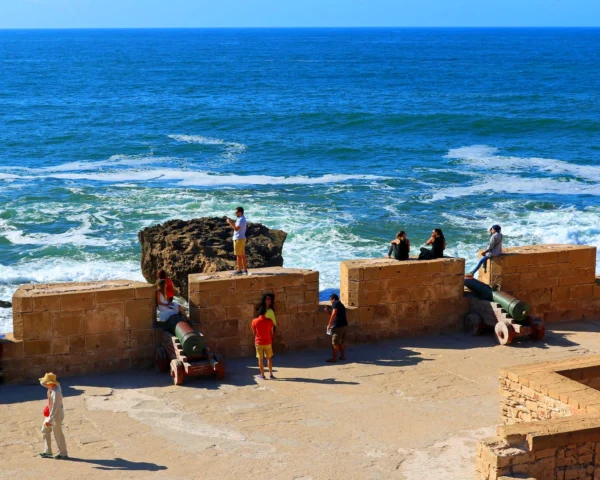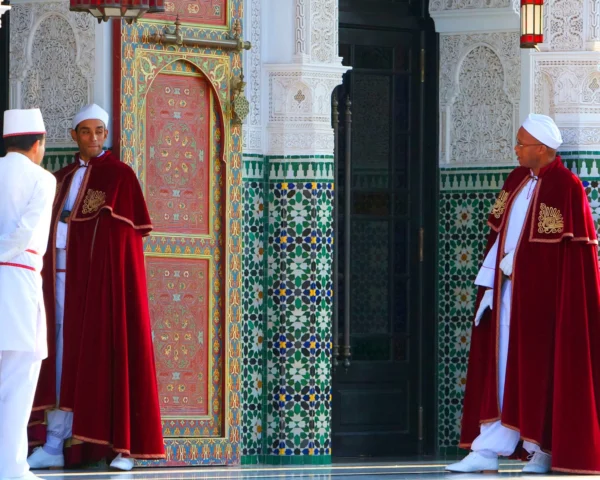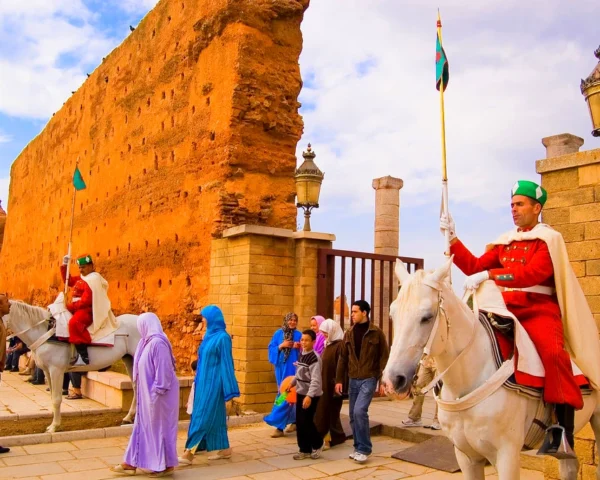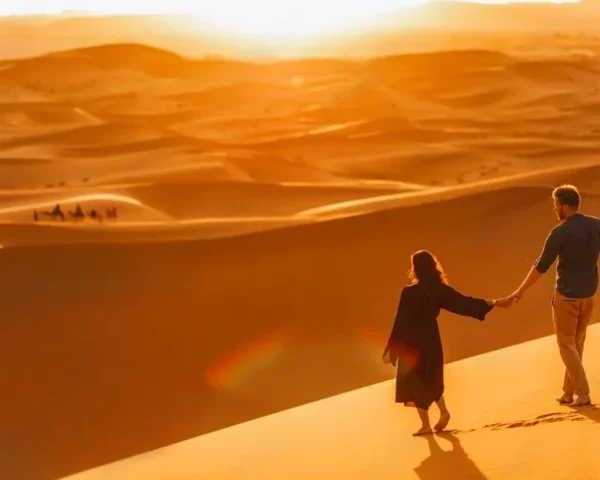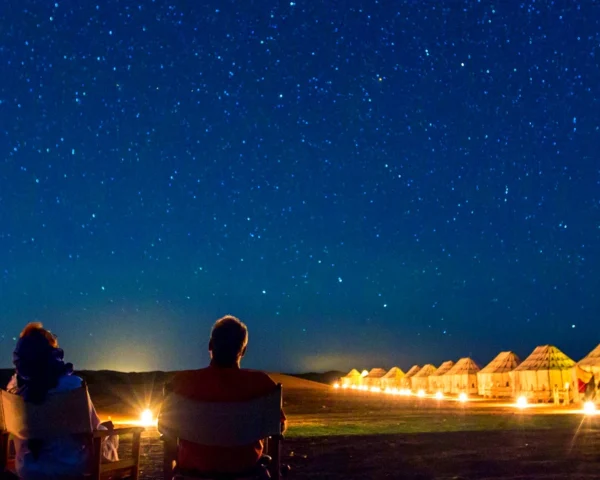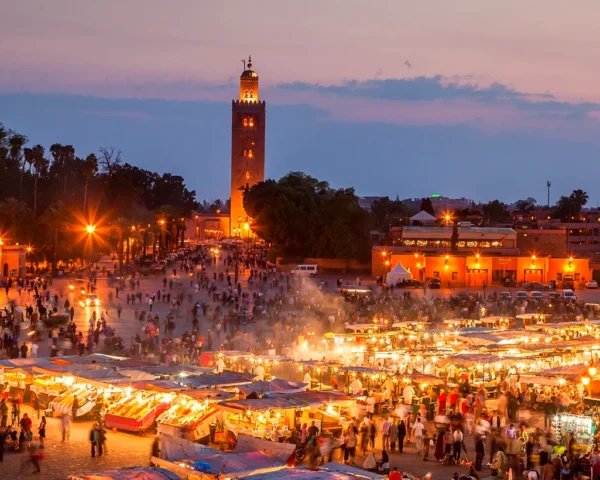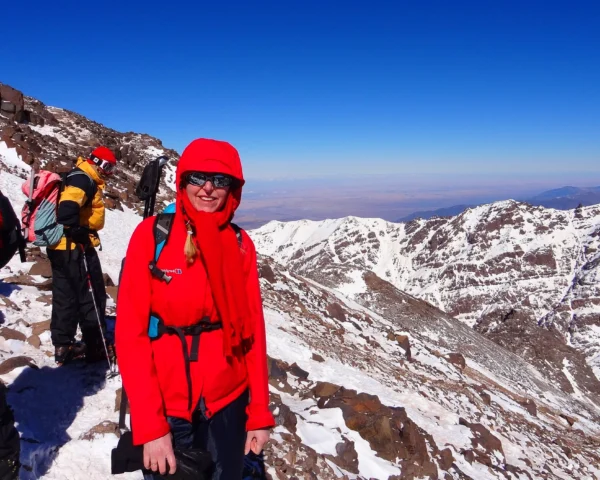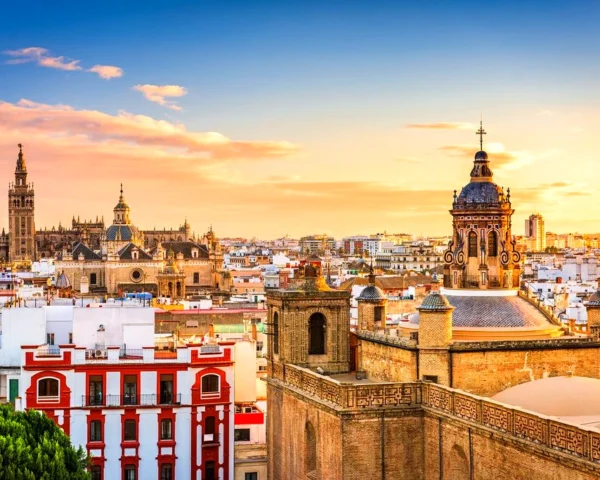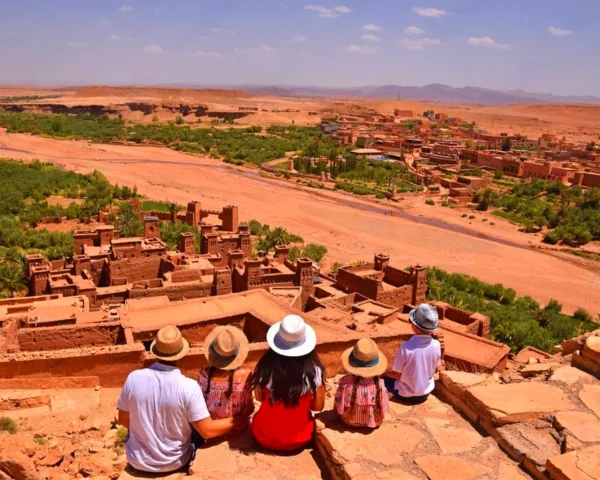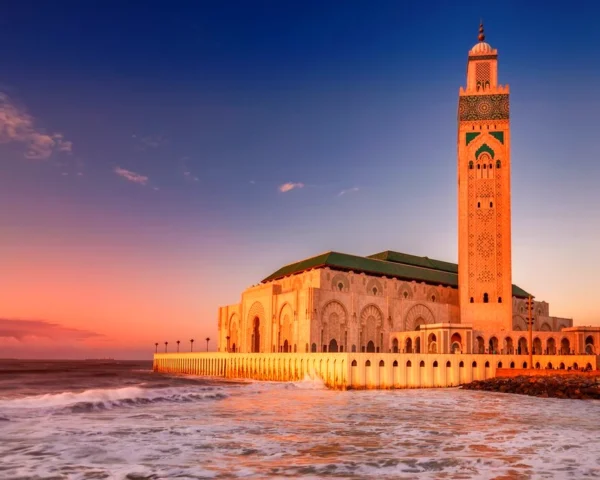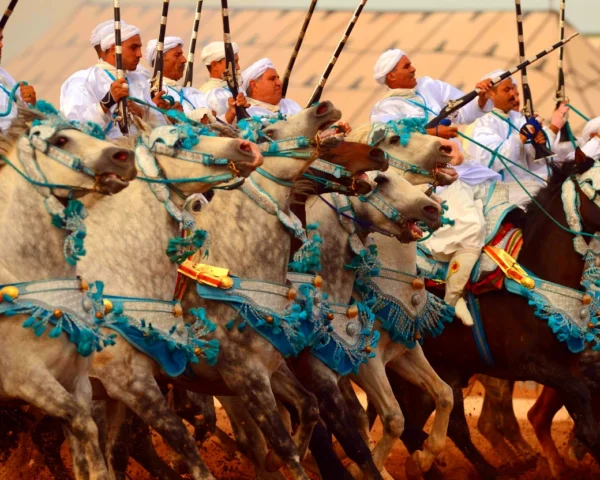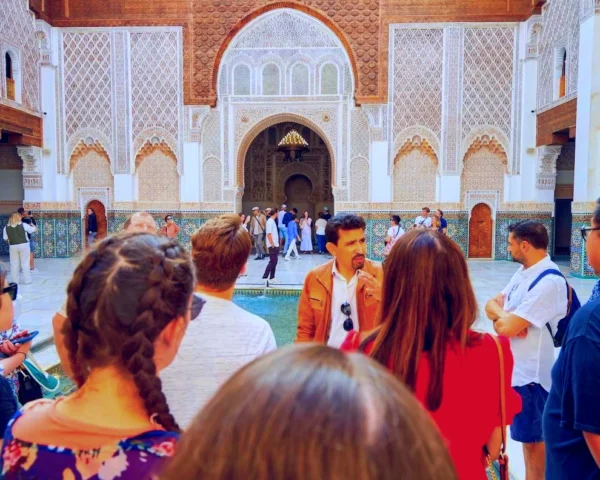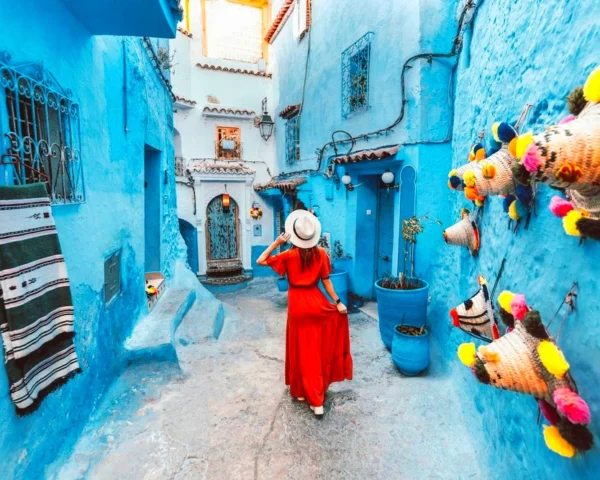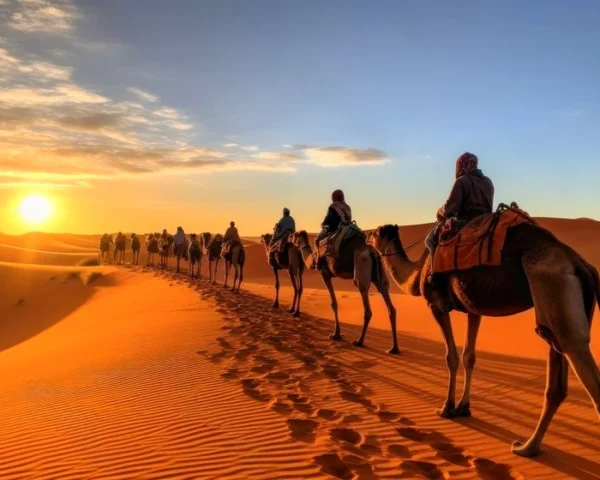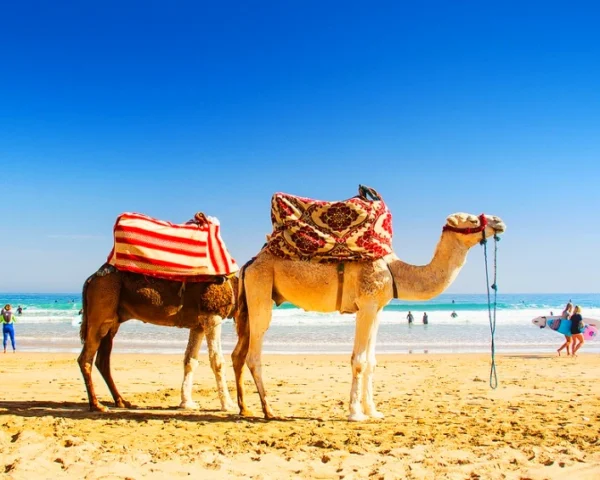About Morocco
Across the Strait of Gibraltar from Spain lies Morocco, a mountainous country in western North Africa. Once the traditional domain of indigenous peoples known as Berbers or Imazighen, Morocco has a rich history of migrations and settlements by various communities. Initially under Carthaginian control, it later became a western province of the Roman Empire. With the Arab conquest in the late 7th century, North Africa, including Morocco, became known as the Maghrib, and Islam spread throughout the region. Moroccan kingdoms wielded political power beyond the coastlines, with the Almoravids becoming the first native Amazigh dynasty in North Africa during the 11th century, ruling over a vast empire.
Despite European attempts to establish footholds in the late 15th century, Morocco resisted and later became a focus of 19th-century Great Power politics before becoming a French protectorate in 1912. Regaining independence in 1956, Morocco stands as the sole monarchy in North Africa today. While modernization has been swift and living standards are rising, Morocco proudly preserves its ancient architecture and traditional customs. Casablanca, its largest city and principal Atlantic port, serves as a key industrial and commercial hub, while Rabat, the capital, sits along the Atlantic coast. Other significant port cities include Tangier overlooking the Strait of Gibraltar, Agadir on the Atlantic coast, and Al-Hoceïma on the Mediterranean Sea. Fès boasts some of North Africa’s most renowned souks, or markets, while the country’s scenic beauty and agricultural richness have been celebrated by luminaries like Ibn Baṭṭūṭah, who hailed Morocco as a land of abundance with plentiful fruits, water, and nourishing food.
Morocco’s Diverse Landscape
Morocco shares borders with Algeria to the east and southeast, Western Sahara to the south, the Atlantic Ocean to the west, and the Mediterranean Sea to the north. It stands out as the sole African nation with access to both the Atlantic Ocean and the Mediterranean Sea. The country’s land area, excluding Western Sahara under its control, is slightly larger than California, a U.S. state. Additionally, the northern coast of Morocco hosts the Spanish enclaves of Ceuta and Melilla.
Geographically, Morocco is characterized by its elevated terrain, with an average altitude of around 2,600 feet (800 meters) above sea level. The country is divided by two mountain ranges into eastern and Atlantic regions: the Rif Mountains bordering the Mediterranean in the north and the Atlas Mountains acting as a central barrier. The connection between these regions is facilitated by the narrow Taza Gap in the northeast and historical routes traversing the landscape. Over millions of years, tectonic forces shaped the Atlas and Rif ranges, originating during the Paleogene and Neogene periods from sedimentation in the Tethys Sea that once bordered North Africa.
The Rif Mountains, part of the Iberian Peninsula’s cordilleras, rise sharply from the Mediterranean coast, with peaks exceeding 4,900 feet (1,500 meters) and reaching 8,058 feet (2,456 meters) at Mount Tidirhine. Meanwhile, the Atlas Mountains consist of three chains: the High Atlas stretching over 460 miles (740 km) with peaks surpassing 13,665 feet (4,165 meters) at Mount Toubkal, the Middle Atlas rising to 10,958 feet (3,340 meters), and the Anti-Atlas extending southwestward to the Atlantic.
To the east of these mountain ranges, the Moulouya basin and the High Plateaus of eastern Morocco present contrasting landscapes, with the former featuring a semiarid lowland shaped by the Moulouya River and the latter resembling extensions of Algerian landforms. Further south and southeast lie arid territories marking the transition to the Sahara desert, with the coastal regions forming plains and plateaus composed of various sediment sizes. Notably, Morocco’s coastline lacks natural harbors, presenting navigational challenges due to offshore sandbars and reefs.
Drainage
In Morocco, the mountains play a crucial role in capturing significant amounts of rain and snow on their windward slopes, resulting in the emergence of numerous perennial watercourses. This has led to the country boasting the most extensive stream network in North Africa. The majority of streams originate from the western slopes of the Atlas Mountains or the southern slopes of the Rif Mountains, flowing westward towards the Atlantic Ocean. Among these waterways, the Sebou stands out, stretching approximately 280 miles (450 km) and holding the highest volume of any Moroccan river. The Sebou, along with its tributaries, accounts for nearly half of the country’s surface water resources. Meanwhile, the Drâa, Morocco’s longest river at around 685 miles (1,100 km) in length, begins in the High Atlas at the convergence of the Dadès and the Imini. Although most parts of the Drâa are typically dry, it remains a significant water body. Another noteworthy river is the Oum el-Rbia, spanning 345 miles (555 km) as it flows from the Middle Atlas to the Atlantic. The Moulouya, the sole major river flowing into the Mediterranean Sea, originates on the eastern slopes of the Middle Atlas and extends about 320 miles (515 km) to its mouth near the Algerian border. Moreover, the northern slopes of the Rif are drained by several short streams that ultimately flow into the Mediterranean. Additionally, various minor streams stemming from the arid eastern slopes of the High Atlas meander into the Sahara, including the Guir, Rheris, and Ziz, forming deep gorges despite their modest volume. Since the 1930s, Morocco has progressively harnessed its streams through dam construction for purposes such as irrigation, hydroelectricity generation, and flood mitigation.
Regarding soils, Morocco features diverse types across different regions. The Chaouïa, Doukkala, and Abda plains exhibit a dark clay-marl soil known as tirs, ideal for growing wheat and barley given sufficient precipitation and moisture retention for summer pasture support. In contrast, Hamri, a light reddish siliceous soil prevalent in the Saïs Plain encircling Meknès and Fès, supports flourishing vineyards and decent cereal yields despite its inferior moisture-holding capacity. The Sebou basin mainly comprises Dhess, a silt-rich alluvial soil crucial for sustaining much of the country’s modern irrigated agriculture. Rmel, a sandy soil found in the Mamora Forest region east of Rabat and along the northern coast, and haroucha, a rocky soil present in Morocco’s semiarid zones, are the primary soil types less conducive to agriculture.
Climate of Morocco
Morocco’s northern region, excluding Western Sahara, especially near the coast, typically enjoys a Mediterranean climate characterized by mild, rainy winters and hot, dry summers. The rainy season usually spans from October to April. While occasional heavy rains can lead to destructive floods, various factors contribute to the overall low rainfall in the country. Located at the southern edge of the mid-latitude zone where frontal storms from the North Atlantic pass through regularly, Morocco experiences relatively limited rainfall that decreases as you move southward. Furthermore, during the rainy season, high-pressure ridges form off the coast, redirecting storms northwards and causing droughts when they persist. The cold Canary Current along the western shores also fosters atmospheric stability, reducing precipitation chances. Rainfall gradually decreases from the northern Gharb plain with around 32 inches (800 mm) annually to less than 8 inches (200 mm) in the Sous valley in the coastal lowlands, transitioning quickly to desert conditions beyond the Anti-Atlas further south. Precipitation levels are significantly higher in mountainous areas with the central Rif receiving over 80 inches (2,030 mm) annually and even the High Atlas in the south getting around 30 inches (760 mm). Snow is common above 6,500 feet (2,000 meters) elevation, persisting until late spring or early summer. The mountains create a rain shadow effect to the east, where desert conditions emerge abruptly. Coastal cities enjoy cooler summer temperatures ranging from 64 to 82 °F (18 to 28 °C) due to onshore breezes, while the interior experiences hotter days exceeding 95 °F (35 °C) frequently. The sharqī (chergui), a hot, dusty wind from the Sahara, can bring scorching temperatures up to 105 °F (41 °C) in late spring and summer, potentially causing crop damage if not harvested. Winters see moderated temperatures along the coast, with average daily temperatures of 46 to 63 °F (8 to 17 °C), dropping significantly further inland, occasionally below freezing.
Plant and Animal Life
In Morocco, vegetation outside the desert areas is reminiscent of the Iberian Peninsula. Diverse forests thrive in the moisture-laden mountainous regions, featuring cork oak, evergreen oak, and deciduous oak at lower altitudes, while fir and cedar dominate higher elevations, especially in the Middle Atlas. In the arid mountain zones, one finds sparse forests of thuja, juniper, Aleppo pine, and maritime pine. Towards the east of Rabat lies the expansive Mamora Forest, predominantly populated by cork oak. The introduction of Eucalyptus from Australia by the French during colonial rule led to extensive plantations of this species encircling the Mamora Forest post-independence. Moving south of Essaouira into the rugged highlands, vast open argan forests, a distinct feature of southwestern Morocco, offer a hard fruit renowned for producing premium cooking oil.
Throughout Morocco, akin to many regions in the western Mediterranean, centuries of human intervention have significantly transformed the natural vegetation. Lower mountain slopes commonly feature dense maquis growth, resulting from activities such as cutting, grazing, and burning, showcasing a mix of wild olive, mastic tree, kermes oak, arbutus, heather, myrtle, artemisia, cytisus, broom, and rosemary. The arid plains inland boast the presence of dwarf palm, jujube tree, esparto grass, and Barbary fig, introduced to Morocco via Spain from the Americas in the 16th century, covering extensive areas. In the desert regions east of the mountains, natural vegetation is scarce, with the notable exception of date palm plantations in the desert oases, dating back to early times in Moroccan history. Over the years, the disappearance of large game species in Morocco, such as lions and elephants since Roman times, has been observed. However, glimpses of gazelles in the south, along with mouflons and fennecs in the Atlas region, still occur. Particularly flourishing under government protection is the Barbary macaque population in the Middle Atlas forests. Presently, the most abundant fauna in Morocco is its birdlife, with prominent migratory species like storks, flamingos, pelicans, and cattle egrets frequenting the country, adding vibrancy to urban landscapes by nesting on city fortifications and mosque rooftops.
People Ethnic Groups
Morocco’s population is a diverse mix of Arabs and Imazighen, with some having a blend of both ancestries. The Imazighen community, predominant in the mountainous regions, has historically found refuge there, enabling them to safeguard their language and heritage. Additionally, Morocco is home to descendants of Spanish refugees who sought shelter during the 15th-century Reconquista. Over time, trade and slavery brought a significant number of sub-Saharan Africans to Morocco, with their offspring now residing primarily in the southern oases and urban centers. Jews, once a sizable minority, began to emigrate in the mid-20th century following the establishment of Israel and the ensuing Arab-Israeli conflict, dispersing to various destinations like Israel, Europe, South, and North America.
Languages
In Morocco, Arabic stands out as a national language spoken by two-thirds of the population, alongside the teaching of Modern Standard Arabic in educational institutions. The Amazigh language, also known as Tamazight, was recognized as an official language in 2011 after being safeguarded in specific Amazigh communities, where it is spoken by approximately one-third of the populace. Among the Amazigh, many are bilingual in Arabic, with Tamazight also being integrated into the school curriculum. Moreover, French holds significant importance as a secondary language, while Spanish enjoys widespread usage. Furthermore, the prevalence of English is on the rise.
The Tamazight-speaking community in Morocco is segmented into three ethnolinguistic factions: the Rif people, known as Rifians, residing in the Rif Mountains; the inhabitants of the Middle Atlas; and the people from the High Atlas and the Sous valley. Despite the dialectal variances present among these groups, they can generally understand each other.
Islam
The predominant religion in Morocco is Islam, with Sunni Muslims following the Mālikī rite comprising the majority of the population. The ruling ʿAlawite dynasty, in power since the 17th century, derives its legitimacy from its lineage tracing back to the Prophet Muhammad, earning veneration from Moroccan Muslims. Sufism, a mystical branch of Islam, attracts followers in the country, where traditions like saint worship and tomb visitation hold significance. While Moroccan law guarantees religious freedom, non-Muslim presence is minimal, with the Christian community being virtually non-existent and the Jewish population dwindling to a mere few thousand.
Settlement Patterns
Traditional Regions
Settlement distributions in Morocco roughly align with the country’s three primary environmental regions: the coastal plains and plateaus, the highland regions of the Rif and Atlas mountains, and the desert areas to the east and south of the Atlas.
The coastal plains and plateaus are inhabited by three-quarters of the nation’s populace, housing most urban centers and nearly all modern agricultural activities. These areas have been occupied by settled farmers and semi-nomadic tribes for generations. Agriculture mainly revolves around rain-fed cereal cultivation, primarily focusing on winter crops like wheat and barley. Livestock rearing and seasonal gardens producing legumes and fresh veggies further complement the farming practices.
The highland territories of the Rif and Atlas are home to around a fifth of the population, acting as strongholds of Amazigh culture. Traditional villages, strategically positioned for defense, are typically situated on hillsides or hilltops. Housing units, often multi-storied, are closely grouped and constructed using stone, adobe, or compacted earth. Due to scarce level land, terraces are meticulously built for cultivating arable fields along the nearby valley slopes. Staple crops include barley as a winter produce and corn and fresh vegetables during the summer. Several villages specialize in commercial cultivation of nuts or fruits, such as olives, almonds, walnuts, and more, suited to the local microclimate. Herding of sheep or goats often complements village farming, with some communities practicing transhumance, migrating seasonally with their livestock to higher or lower elevation pastures, dwelling in goat hair tents.
The pre-Saharan and Saharan regions south of the Atlas accommodate a minute fraction of Morocco’s population. Some settlements are inhabited by ḥarāṭīn, descendants of sub-Saharan Africans, who speak various Tamazight dialects. Settlements mainly thrive in oases, often created artificially by redirecting water from streams or transporting it from mountains through underground tunnels known as qanāts. Dates constitute the primary crop, serving both subsistence and commercial purposes. Underneath date palms, alfalfa, corn, wheat, barley, vegetables, and other crops are cultivated. Distinctive fortified adobe villages, termed ksour, dominate this region’s landscape. Nomadic camel herding, once a vital economic activity, has almost entirely vanished due to governmental policies, desert conflicts, prolonged droughts, and other contributing factors.
Urban Settlement
About three-fifths of the Moroccan population currently resides in urban regions. Most Moroccan cities have managed to preserve some of their traditional charm and character. Back in the era of the French protectorate, the colonial authorities made a conscious decision not to interfere with the traditional urban hubs, known as medinas (madīnahs), which were typically enclosed by walls. Instead of altering these historic centers to incorporate new infrastructure for governance and economic progress, they opted to create villes nouvelles (“new towns”) adjacent to them. Furthermore, they relocated the focal point of political and economic activities from Morocco’s interior—where cities like Fès, Meknès, and Marrakech had long been at the core—to the Atlantic coast. During the protectorate period, Casablanca underwent a remarkable transformation from a modest coastal settlement to a vibrant metropolis, while Rabat was designated as the administrative capital. By the 1930s, bidonvilles (literally translated as “tin can cities”), or informal settlements, started emerging around major urban centers and have since proliferated.
Demographic Trends
Morocco has a population that is increasing slightly faster than countries outside Africa, yet it remains below the average growth rate seen in the Middle East and North Africa. Despite this, Morocco boasts a sizable population relative to its size, with a significant concentration in the more hospitable regions. Approximately one-fourth of the population is under the age of 15. In the past, the opportunity for emigration to Western European nations provided some relief to Morocco’s population challenges, leading to around 600,000 Moroccan workers and traders settling in Western Europe by the early 1980s. Migration to the labor markets of the Persian Gulf region during the oil boom of the late 20th century provided some minor alleviation to Morocco’s population concerns.
Economy of Morocco
In many ex-colonies of Africa, including Morocco, the economy heavily relies on exporting raw materials. However, the country is increasingly shifting towards modern sectors such as tourism and telecommunications, which now contribute over two-thirds of the GDP despite only employing around one-third of the workforce. Since the mid-1980s, the Moroccan government has been actively pursuing privatization and economic reforms, with support from global financiers like the World Bank and the IMF. These efforts have involved privatizing state-owned companies, currency devaluation, and adjusting pricing strategies to promote local manufacturing. In 1999, the Moroccan government established a fund to provide loans to small businesses, aiming to spur growth and competition. With its stunning beaches, sunny weather, diverse landscapes, and rich cultural history, Morocco holds significant potential for tourism, an industry that the government is actively fostering.
Agriculture, Forestry, and Fishing
Morocco possesses a wealth of exploitable resources. With around 33,000 square miles (85,000 square km) of fertile land, a significant portion of which is suitable for irrigation, and a generally pleasant Mediterranean climate, Morocco’s agricultural capabilities are among the most promising in the Arab and African regions. The country stands out as one of the rare Arab nations with the potential to attain self-sufficiency in food production. Typically, in a given year, Morocco harvests about two-thirds of the grains required for local consumption, with wheat, barley, and corn (maize) being the main crops. Additionally, Morocco exports citrus fruits and fresh vegetables to Europe, boasts a well-established wine industry, and is witnessing growth in the production of cash crops like cotton, sugarcane, sugar beets, and sunflowers. Emerging crops such as tea, tobacco, and soybeans have shown promise beyond the experimental phase, with the fertile Gharb plain providing an ideal environment for their cultivation. The country is actively enhancing its irrigation infrastructure, which is projected to cover over 2.5 million acres (1 million hectares) of land once completed.
However, the persistent threat of drought looms large. Particularly vulnerable are the low-lying plains dedicated to cereal cultivation, as they experience significant fluctuations in annual rainfall. On average, drought hits Morocco every third year, posing a major challenge to the stability of agricultural output and hindering sector expansion. Livestock rearing, notably sheep and cattle farming, is widespread. Morocco meets its own meat demands and is striving for self-sufficiency in dairy production.
Morocco’s forests, accounting for around one-tenth of its total land area (excluding Western Sahara), hold substantial economic value. The country largely fulfills its timber requirements by exploiting the forests of the Middle and High Atlas mountains. Eucalyptus plantations enable Morocco to meet its charcoal needs independently, extensively used as a cooking fuel. Furthermore, eucalyptus serves as a primary resource for the nation’s paper and cellulose industries. Morocco’s paper pulp and cork from abundant cork oak forests are valuable exports.
The fishing waters along Morocco’s west coast in the Canary Current teem with sardines, bonito, and tuna; however, the country lacks modern fishing fleets and processing facilities to fully capitalize on these marine resources. Of significant importance was a key component of a substantial trade pact inked between Morocco and the European Union in 1996 concerning fishing rights. The EU pays an annual fee to Morocco for access to its waters, primarily benefitting Spanish vessels.
Resources and Power
Morocco’s acquisition of Western Sahara granted it control over around two-thirds of the global phosphate reserves, essential for producing fertilizers and various goods. Nevertheless, the production has been impeded by the low international phosphate prices. Apart from phosphates, Morocco also mines minerals like iron ore and coal for internal consumption, while exporting barite, manganese, lead, and zinc in limited quantities. The country’s energy resources are notably lacking, with oil exploration yielding unsatisfactory results. Despite possessing natural gas reserves, they have only been partially exploited. Morocco is making efforts to harness its substantial hydroelectric potential. To meet its increasing energy demands, Morocco heavily relies on imports, primarily crude oil that is refined domestically. The country heavily depends on thermal power plants for generating most of its electricity output.
Manufacturing
Manufacturing, which accounts for approximately one-sixth of the GDP, is progressively gaining significance in the economy. The country’s industrial landscape consists of two vital elements: processing raw materials for export and producing consumer goods for the local market. Many of these operations trace their roots back to the colonial era. Historically, government intervention prevailed until the early 1980s, with a primary focus on import substitution. However, there has been a notable shift towards privatizing state-owned enterprises and attracting new private investments, including foreign capital. Notably, a key economic activity involves processing phosphate ore to produce fertilizers and phosphoric acid for export. Additionally, food processing plays a crucial role, encompassing the canning of fish, fresh vegetables, and fruits for export purposes, as well as meeting domestic demands through flour milling and sugar refining. Moreover, the textile and garment industry, utilizing locally sourced cotton and wool, serves as a significant foreign exchange earner. Although Morocco’s iron and steel manufacturing sector is relatively small, it fulfills a notable portion of the country’s domestic requirements.
Finance
The Bank al-Maghrib in Morocco holds a crucial position within the nation’s banking sector. It is responsible for issuing the Moroccan dirham, managing the country’s foreign currency reserves, monitoring the credit flow, supervising specialized government lending institutions, and overseeing the commercial banking sector. The privatization efforts have breathed new life into the Casablanca Stock Exchange, one of Africa’s oldest exchanges founded in 1929, particularly invigorating trading activities involving shares of major formerly state-owned enterprises.
Trade
Morocco has made strides in enhancing its export initiatives and regulating imports, leading to a reduction in its chronic annual trade deficit. By the 1990s, the country had made significant progress in decreasing its foreign debt. The primary exports comprise agricultural products like citrus fruits and vegetables, partially processed goods, consumer goods such as textiles, as well as phosphates and phosphate products. Noteworthy imports consist of semi-manufactured goods, industrial equipment, crude oil, and food items. The European Union stands as Morocco’s most substantial trading partner. The 1990s marked a crucial milestone with the initiation of negotiations for a formal association with the EU, aiming to establish a Euro-Mediterranean free trade zone gradually. To diversify trade relations and reduce reliance on Europe, Morocco has pursued additional trade agreements with NAFTA countries, bilateral arrangements with nations in the Middle East and North Africa, and signed a Free Trade Agreement with the United States in 2004.
Services
Accounting for approximately one-fourth of Morocco’s GDP, services, which include government and military spending, play a significant role in the country’s economic landscape. Despite the government’s continuous efforts to privatize many of its assets, government expenditures alone make up half of the service sector. Since the mid-1980s, tourism and related services have emerged as a key player in the Moroccan economy, eventually becoming the largest source of foreign currency by the late 1990s. To boost this sector, the Moroccan government heavily invested in loans, tax breaks, and direct capital injections. However, starting from the early 1990s, the government started to withdraw from these investments. With millions of visitors, predominantly from Europe, entering Morocco annually, the tourism industry has attracted tourists from regions like Algeria, the United States, and East Asia, particularly Japan.
Labour and Taxation
Around 33% of the population is engaged in agriculture, with another 33% working in mining, manufacturing, and construction, while the rest are involved in trade, finance, and services. These figures do not account for a significant informal sector comprising street vendors, domestic workers, and others who are underemployed and receive low wages. The country faces a notable issue with high unemployment rates; the official rate stands at approximately 20% of the workforce, but unofficial projections suggest it is much higher. This mirrors a common trend in many Middle Eastern and North African nations, where unemployment is particularly prevalent among university graduates holding non-technical degrees. The nation hosts several trade unions, the largest being L’Union Marocaine du Travail, with almost 700,000 members, affiliated with the International Confederation of Free Trade Unions. The primary source of revenue for the general budget is derived from taxes imposed on individuals, corporations, goods and services, as well as tobacco and petroleum products.
Transportation and Telecommunications
Morocco boasts an extensive road network that effectively links its diverse regions, a legacy of the colonial era. Over time, this network has not only been well-preserved but also expanded to cater to evolving needs. The railway system connects major urban hubs in the northern part of the country, with new rail connections and enhanced roads extending to El-Aaiún (Laâyoune) in Western Sahara. Additionally, Morocco features approximately twenty-four ports along its extensive coastline, with Casablanca handling a significant portion of the port tonnage, closely followed by Tangier. Other prominent ports include Safi, Mohammedia, Agadir, Nador, Kenitra, and El Jorf Lasfar. The country is served by about twelve airports equipped to accommodate large aircraft, with the primary international airport situated near Casablanca. Royal Air Maroc (RAM), the state-owned airline, offers regular flights to Europe, North America, the Middle East, and West Africa.
In the late 1980s and early 1990s, the government embarked on a substantial modernization and expansion initiative for the telecommunications infrastructure. This initiative led to a nearly fourfold increase in internal telephone lines and considerable enhancements in international communication capabilities. The privatization of the state-owned telecommunications industry was initiated in 1996 through legislation allowing private investment in the retail sector, while state control over fixed assets was retained. Maroc Telecom, established in 1998 by the government, delivers telephone, cellular, and Internet services across the country. The widespread presence of satellite dishes, even in the most impoverished neighborhoods, indicates broad access to the global telecommunications network across all social strata. The Internet has gained significant traction in Morocco, with major institutions having direct connectivity and private individuals accessing it through “telecommunications boutiques,” akin to cyber cafés in Western nations, as well as home computers.
Government and society
Constitutional framework
Morocco operates as a constitutional monarchy, comprising two legislative bodies. Established in 2011, the country’s constitution outlines a power-sharing system between the hereditary monarch and an elected bicameral parliament. This parliament consists of the House of Councillors (Majlis al-Mustashārīn) and the House of Representatives (Majlis al-Nawāb). Overseeing the executive branch is a prime minister who leads the cabinet.
Despite the constitutional framework and active political landscape marked by various parties, the king retains significant political power. This authority allows the monarch to enact laws, select the prime minister from the leading parliamentary party, and approve governmental appointments. Critical domains such as religious affairs, armed forces, and national security policy fall under the king’s absolute control.
The monarch’s dominant role in Moroccan politics has sparked substantial debate and critique. In response to internal and external pressures since the 1990s, political reforms have sought to bolster representative entities, empower parliament and the cabinet, expand political engagement, and curtail the monarch’s influence over political matters. Notably, in July 2011, Moroccan voters endorsed a new constitution proposed by King Muḥammad VI. This revised constitution aimed to enhance the authority of parliament and the prime minister while still granting the king sweeping powers across all government branches. Additionally, the constitutional changes included provisions promoting cultural diversity in Morocco and officially recognizing the Tamazight language.
Local Government
Morocco’s local governance system consists of various tiers under the authority of the Ministry of the Interior. The highest tier comprises 16 regions, which are then subdivided into multiple provinces and urban prefectures, each overseen by a governor appointed by the monarch. Below this level, there are rural districts and municipalities governed by chefs de cercle. Further down, there are rural communes and autonomous urban centers led by qāʾids (caids) and pashas, respectively. Officials at lower levels are appointed by either the Ministry of the Interior or the governors. Each tier has democratically elected bodies responsible for addressing local issues, initiating development projects, and managing budget allocations. By the late 1990s, there was a notable shift in government policy towards granting more decision-making powers to the local authorities.
Justice
The Qur’an remains the primary source of law, with qāḍīs (Muslim religious judges) overseeing matters concerning the personal status of Muslims. Rabbinical law applies to Jews, while all other issues are handled by secular courts following a French-based legal framework. The Supreme Court is the ultimate legal authority, overseeing a system comprising appellate courts, regional tribunals, magistrates’ courts, and local courts. Judges are appointed by the king and regulated by the Ministry of Justice. Though subject to reform pressures, especially from Moroccan women advocating for changes in the Mudawwanah (personal status and family law code) to address gender-based inequalities in inheritance and divorce, a new progressive personal status code was introduced by parliament in 2004.
Political Process
Within the House of Councillors, made up of 120 members, individuals are selected by local councils, trade unions, and professional associations, serving terms lasting six years. In contrast, the House of Representatives comprises 395 members who are elected directly through popular vote for five-year terms. The Constitution of the nation explicitly prohibits a one-party system, leading to the existence of multiple political parties, each aligning either with a “pro-palace” or reformist ideology. A pivotal moment in Moroccan politics unfolded during the 1997 legislative elections, where a reform-focused coalition superseded the pro-palace coalition. Subsequently, from 2011 to 2021, the Islamist Justice and Development Party (Parti de la Justice et du Développement; PJD) held a predominant position in parliament but encountered challenges in garnering adequate support from other parties for effective governance. Following a restructuring of seat allocations in 2021, parties endorsing the king’s agenda regained majority control. Notably, significant power remains vested in the Ministry of the Interior and the security forces. Islamist factions persist as influential players in the political arena, posing a continual challenge to the monarchy. While more moderate groups like the PJD were assimilated into the political framework after the 1997 elections, more radical factions such as al-ʿAdl wa al-Iḥsān have maintained a strong presence, particularly among university students and unemployed youth, occasionally resorting to violent means. Despite constitutional provisions ensuring equal rights for all citizens in realms such as education, employment, and property ownership, disparities persist, particularly concerning gender equality. Implementation of electoral quotas has notably enhanced female participation in legislative bodies, with 90 seats reserved for women in the House of Representatives and a one-third quota in regional and local governing bodies being mandated.
Security
The military forces of the nation are comprised of the Royal Armed Forces, encompassing the army as the primary branch, alongside a modest navy and air force, the National Police Force, the Royal Gendarmerie with a focus on rural security, and the Auxiliary Forces. Male individuals aged between 19 and 25 are required to enlist for conscription, with a percentage selected for a year-long service period; females have the option to volunteer for conscription. The country maintains a robust internal security system, with rare occurrences of political violence except for a notable terrorist attack in May 2003 in Casablanca that resulted in numerous casualties. The United Nations oversees a limited observer presence in Western Sahara, a region where a significant portion of Morocco’s military personnel are stationed. The Saharawi faction Polisario commands an active militia estimated to consist of 5,000 combatants in Western Sahara, where sporadic clashes with Moroccan troops have persisted since the 1980s.
Health and Welfare
Morocco boasts a relatively advantageous ratio of physicians and skilled medical staff per capita. The government’s focus on preventive healthcare is evident through the expansion of dispensaries and health centers. Despite these efforts, over half of the rural population lacks adequate access to such facilities. Moreover, safe drinking water is not accessible to all urban inhabitants and only a fraction of those in rural areas. High infant mortality rates persist, and malnutrition affects at least one-third of the population. Ongoing challenges include prevalent diseases like hepatitis and the increasing incidence of conditions such as schistosomiasis due to the expansion of irrigation systems.
Housing
Housing options in Morocco present a diverse mix of traditional and cutting-edge designs. In remote areas, some Moroccans still call ksour and rural villages home, where living conditions can be challenging. Despite ongoing initiatives by the government and private organizations to revamp and modernize the historic medinas, access to public services in many urban centers remains inadequate. While authorities previously discouraged the growth of bidonvilles and spontaneous settlements, recent efforts have focused on enhancing these areas with amenities such as electricity and piped water, while urging residents to upgrade their homes. New housing developments across the country, championed by the government and private sector, mainly cater to the middle class. Unsanctioned permanent settlements have sprung up on the outskirts of cities. The government aims to regularize these illegal dwellings by improving their quality and providing essential services, albeit post-construction.
Education of Morocco
Approximately 20% of Morocco’s budget is dedicated to education, with a significant portion used for constructing schools to cater to the expanding population. Education is obligatory for children aged 6 to 15, but while urban areas show high attendance rates within this age group, national figures portray a notable decline in participation. Around 75% of school-age boys attend school, compared to only half of school-age girls, with even lower figures in rural regions. A little over half of students continue to secondary education, with a minority pursuing higher education. The country faces challenges of poor attendance in rural areas leading to a low literacy rate of around 40%. Morocco boasts over 50 higher education institutions spread across urban areas, featuring prominent universities like Muḥammad V University in Rabat, Hassan II Agriculture and Veterinary Institute in Rabat conducting influential research, and Al-Akhawayn University in Ifrane, an English-language university established in 1995 with support from Saudi Arabia and the U.S.
Cultural Life
Cultural Milieu
Morocco’s rich history is a tapestry woven with the threads of various cultures and ethnicities from Europe, sub-Saharan Africa, and the Middle East. Since ancient times, the land has served as a meeting point where different groups have traversed, imprinting their influence. The indigenous Amazigh culture, existing since the 8th century, encountered Arab conquerors and travelers who introduced Islam and the profound impact of Arabic customs. The influx of Jewish and Muslim refugees following the Spanish Reconquista in the 16th century added an enduring Andalusian essence to Moroccan society. In the 19th century, French cultural dominance, intertwined with political supremacy, started seeping into the fabric of North Africa, leaving an indelible mark on Moroccan heritage. This French cultural sway, accompanied by the persistent use of the French language, continues to shape modern-day Morocco. Furthermore, a revival of interest in Amazigh culture has emerged among some Moroccans, leading to the establishment of civic organizations promoting the exploration of Tamazight literature and oral traditions.
Daily life and Social Customs
In Morocco, the nucleus of social life for most individuals revolves around their homes and families. Men often gather at sidewalk cafes, while catching a football match on TV in a local cafe is a popular form of entertainment. In major cities like Casablanca, a plethora of recreational options await, ranging from cinemas, restaurants, to shopping at modern boutiques or the bustling souk, an open-air market teeming with vendors selling local arts and crafts, food, and imported goods. Morocco’s extensive coastline offers pristine beaches, some exclusive and others open to the public, perfect for families who spend weekends swimming, picnicking, and engaging in sports activities.
Moroccan gastronomy has garnered global acclaim, thanks to the country’s fertile agricultural regions yielding a bounty of ingredients. From fish, lamb, and fowl to the prized pigeon delicacy baked in pastry known as b’stilla, Moroccan cuisine is a culinary delight. The cuisine features an array of vegetables like tomatoes, peppers, onions, and eggplants, alongside a variety of fruits. Bread holds significant cultural importance and is a staple in daily meals. The iconic dish, couscous, served with a flavorful meat stew, reigns supreme in Moroccan dining. Kebabs, salads, and soups are commonplace, with Harira, a hearty lamb soup, taking the spotlight during Ramadan. Mint tea is the national drink of choice. While Morocco produces wine, production faced a decline in the 21st century due to religious sentiments opposing alcohol consumption.
Moroccans celebrate a blend of secular and religious festivals. Islamic festivities include Eid al-Fitr, Eid al-Adha, and the Prophet’s birthday (mawlid), while national holidays encompass Independence Day and the monarch’s birthday.
The Arts
The landscape of Moroccan literature has been evolving steadily, branching out into various forms beyond the traditional genres of poetry, essays, and historiography. Inspired by literary models from the Middle East and the West, new forms have emerged, adding diversity to the literary scene. In academic circles, French is commonly used for research in social and natural sciences, while literature and literary studies see works being published in both Arabic and French languages. Renowned Moroccan writers like Mohammed Choukri, Driss Chraïbi, Abdallah Laroui, Abdelfattah Kilito, and Fatima Mernissi showcase their works in French and English, broadening their reach. Additionally, expatriate writers such as Pierre Loti, William S. Burroughs, and Paul Bowles have not only highlighted Moroccan writers but also shed light on the cultural richness of the country itself.
Since gaining independence, Morocco has witnessed a flourishing of artistic endeavors in painting, sculpture, music, theater, and filmmaking. The Moroccan National Theatre, established in 1956, stages regular productions of Moroccan and French dramatic works. The country comes alive during the summer months with art and music festivals held nationwide, including the renowned World Sacred Music Festival in Fès.
Moroccan music, a fusion of Arab, Amazigh, African, and Spanish influences, showcases a variety of traditional instruments like the nāy flute, ghaita shawm, qanūn zither, and the ʿūd and gimbrī lutes, complemented by vibrant percussion from the darbūkka terra-cotta drum. Internationally acclaimed traditional Moroccan artists include the Master Musicians of Jajouka, a male guild known for their lifelong training, and Hassan Hakmoun, a virtuoso of gnāwa trance music rooted in sub-Saharan Africa. The younger generation in Morocco resonates with raï music, an Algerian genre that blends traditional elements with Western rock, Jamaican reggae, and influences from Egyptian and Moroccan popular music.
Cultural Institutions
Throughout Morocco, there are several notable museums. For instance, the Batha Museum in Fès, housed in a former 19th-century royal residence, boasts a remarkable collection of historical Moroccan art, particularly native ceramics. Another notable museum is the Oudaïa Museum, established in 1915 near Rabat’s Oudaïa Casbah. Initially a 17th-century private residence, it now showcases collections of premodern Moroccan arts and crafts. Similarly, the Dar El-Jamaï Museum in Meknès, founded in 1920, also exhibits a diverse range of Moroccan arts and crafts. Additionally, Rabat’s Archaeological Museum, established in 1931, offers an extensive collection that spans Morocco’s rich history. Moreover, the country is home to various learned societies, research institutes, and archives.
Sports and Recreation
In Morocco, spectator sports have traditionally revolved around the equestrian arts. However, at the end of the 19th century, European sports such as football (soccer), polo, swimming, and tennis were introduced, diversifying the sporting landscape. Football has emerged as the nation’s leading sport, capturing the hearts of urban youth, and in 1970, Morocco made history as the first African country to participate in World Cup competition. The 1984 Olympic Games marked another milestone for Morocco, with two athletes clinching gold medals in track and field events. Among them, Nawal El Moutawakel triumphed in the 400-meter hurdles, becoming the first woman from an Arab or Islamic nation to secure an Olympic gold. Additionally, tennis and golf have garnered significant popularity, with Moroccan professional players shining on the international stage, culminating in the country’s inaugural Davis Cup team debut in 1999.
Media and Publishing
Morocco boasts an extensive media landscape overseen by the state-owned Radiodiffusion Télévision Marocaine (RTM), which airs nationwide. Radio programs are available in Arabic, French, Tamazight, Spanish, and English, while television broadcasts cover Arabic, Tamazight, and French content. Furthermore, Casablanca is home to a private TV network, with a private radio station based in Tangier. The country supports around twelve daily newspapers, circulated in Rabat, Casablanca, and Tangier, featuring content in both French and Arabic. Many of these newspapers are affiliated with political parties, while others exhibit alignment with or ownership by the government. Various professional, trade, intellectual, and recreational interests are represented in a diverse range of periodicals. Despite this, the prevalence of illiteracy hampers readership levels, leading television to serve as the primary source for news and information dissemination.
History
This text delves into the history of Morocco from the 16th century onwards, shedding light on its resilience against external threats and its role as a crossroads for European, Eastern, and African cultures. The early inhabitants, the Imazighen or Berbers, embraced Christianity and Judaism under Roman influence before gradually adopting Islam brought by Arab conquerors in the late 7th century. The doctrinally strict Almohad dynasty solidified Sunni Islam’s dominance in the 12th and 13th centuries, while the influx of Muslim and Jewish exiles from Spain following the Christian Reconquest infused Moroccan urban life with a Hispanic flair. Despite various attempts by outsiders like Ottoman invaders in the 16th century, Morocco managed to maintain its independence, emerging as the only Arab nation to evade Ottoman rule. The Battle of the Three Kings in 1578 marked a significant victory for Morocco against European forces, leading to a three-century hiatus in foreign incursions. The 17th century witnessed the ascent of the ʿAlawite dynasty, shaping Morocco’s trade and cultural ties with Africa, Europe, and the Arab world amidst intermittent religious tensions. The consolidation of Morocco’s Islamic monarchy under sultans like Mawlāy Ismāʿīl in the late 17th century laid the foundation for centralized rule and stability, with subsequent rulers leveraging religious authority to mitigate tribal rivalries. As Europe grappled with revolution and conflict in the late 18th and early 19th centuries, Morocco embraced isolation, remaining largely unfamiliar to its European neighbors despite their geographical proximity.
Decline of traditional government (1830–1912)
In 1830, during the French invasion of Algeria, the Sultan of Morocco, Mawlāy ʿAbd al-Raḥmān (1822–59), momentarily dispatched troops to occupy Tlemcen but retracted them following French objections. Later, in 1844, the Algerian leader Abdelkader sought refuge from the French in Morocco. This led to a Moroccan army being sent to the Algerian border, triggering French bombardments on Tangier and Essaouira (Mogador). Subsequently, near Oujda, the Moroccan forces faced a decisive defeat at Isly on August 14, 1844. The Sultan then pledged to either intern or expel Abdelkader should he reenter Moroccan territory. When Abdelkader was once again pushed into Morocco two years later, he was confronted by Moroccan troops and eventually surrendered to the French.
Following the death of ʿAbd al-Raḥmān in 1859, a conflict with Spain regarding the boundaries of the Spanish enclave in Ceuta led to Madrid declaring war. Spain managed to capture Tétouan the following year. Eventually, peace was achieved through a substantial indemnity of $20 million, the expansion of Ceuta’s borders, and the commitment to cede another enclave, Ifni, to Spain.
The subsequent ruler, Sīdī Muḥammad, made efforts to modernize the Moroccan army with limited success. After his passing in 1873, his son Mawlāy Hassan I strived to safeguard Morocco’s independence. However, internal challenges persisted, leading to instability and unrest. The reign of ʿAbd al-ʿAzīz, who took over after Hassan I’s death in 1894, was marked by attempts at modernization, European influences, and growing discontent among the population and religious figures.
In the early 20th century, European powers solidified their influence in Morocco through diplomatic agreements. The Algeciras Conference in 1906 formalized French and Spanish policing of Moroccan ports and customs collection. Subsequently, a rebellion against ʿAbd al-ʿAzīz by his brother, Mawlāy ʿAbd al-Ḥāfiẓ, in 1907–08, culminated in the latter being declared sultan with European support in 1909.
Despite the turmoil, internal strife, and external pressure, ʿAbd al-ʿAzīz was unable to maintain control, leading to his eventual flight and the signing of the Treaty of Fez in 1912, establishing a French protectorate over Morocco while preserving the sultan’s nominal authority. Additionally, provisions were made to address Spanish interests in the northern territories, with Tangier maintaining a distinct administrative status as a key diplomatic center.
The French protectorate (1912–56)
The French drew upon their prior experiences in Algeria and Tunisia when establishing their protectorate over much of Morocco. However, there were notable distinctions in this endeavor. Unlike Tunisia, the Moroccan protectorate came into existence shortly before the onset of World War I, ushering in a fresh approach to colonial governance. Morocco stood out due to its long history of independence, untouched by Ottoman rule despite being significantly influenced by Muslim Spain. The country’s geographical proximity to Spain fostered a unique bond between the two nations.
Morocco’s geographical features, including its Atlantic coastline, set it apart from other North African nations. The delineation of territories based on the Act of Algeciras granted various rights to different countries, with Tangier hosting diplomatic missions with special privileges. A portion of the country, encompassing the northern tenth with coastlines on both the Atlantic and Mediterranean, as well as the desert province of Tarfaya adjacent to Spanish Sahara, fell under Spanish protection outside French control. Within the French-controlled zone, the nominal sovereignty of the sultan was upheld, yet true authority rested with the French-appointed resident general, answerable solely to the Paris government. The Moroccan government, represented by the makhzan, held minimal sway, exemplified by the grand vizier Muḥammad al-Muqrī retaining his position from the protectorate era to Morocco’s independence over four decades later, despite being over a century old by then. Administration in rural areas mirrored the Tunisian model, with civil administrators overseeing most regions, although certain locales like Fès mandated higher-ranked military officers. Southern Amazigh chiefs, notably Thami al-Glaoui, enjoyed significant autonomy under the protectorate system.
The pre-World War II Period
The initial French resident general, Gen. (later Marshal) Louis-Hubert-Gonzalve Lyautey, had a rich military background in various regions such as Indochina, Madagascar, and Algeria. With a noble perspective and a profound understanding of Moroccan culture, Lyautey’s governance style had a lasting impact throughout the protectorate era.
He aimed to maintain the integrity of the Moroccan elite while implementing a policy of cooptation. This strategy led to the placement of Mawlāy Yūsuf, a more cooperative brother of ʿAbd al-Ḥāfiẓ, on the throne. The collaboration between this sultan and the French authorities was successful without compromising the respect of the Moroccan populace. Under Lyautey’s direction, a new administrative hub was established in Rabat on the Atlantic coast, followed by the development of a bustling commercial port in Casablanca. By the conclusion of the protectorate in 1956, Casablanca had evolved into a thriving city with nearly a million residents and a thriving industrial sector. Lyautey’s concept of constructing new European settlements alongside existing Moroccan cities preserved the traditional medinas. Surprisingly, the momentum of progress persisted even during World War I. Despite the French government’s proposal to retreat to the coast during the war, Lyautey effectively maintained control over all the French-held territories.
Post-war, Morocco encountered two significant challenges. The first involved pacifying the remote regions in the Atlas Mountains, formerly beyond the jurisdiction of the sultan’s rule, which was eventually achieved in 1934. The second hurdle was containing the uprising led by Abd el-Krim, which spread from the Spanish to the French zone and was suppressed by French and Spanish forces in 1926. That same year, a civilian resident general succeeded Marshal Lyautey, ushering in a transition towards a more traditional colonial administration emphasizing official colonization, the growth of the European populace, and the increasing influence of European ideologies on the younger Moroccan generation, many of whom had acquired a French education by then.
As early as 1920, Lyautey had warned of a burgeoning youthful generation seeking greater opportunities and outlets due to the limitations of the existing administration. Just six years after Lyautey’s warning, young Moroccans in Rabat and Fès were independently convening to advocate for reforms within the protectorate’s framework, including enhanced education, a revised legal system, and the abolition of the Amazigh qāʾids’ regime in the south. They also pushed for educational trips to France and the Middle East, as well as an end to official colonization, objectives that would only be fully realized upon the termination of the protectorate in 1956.
Upon the passing of Mawlāy Yūsuf in 1927, his younger son Sīdī Muḥammad (Muḥammad V) was appointed as his successor, partly due to his reserved demeanor. Muḥammad V later displayed remarkable diplomatic skills and resolve. The French administration’s attempt to exploit perceived differences between Arabs and Imazighen resulted in the controversial Berber Decree of 1930, which backfired by generating a united Moroccan nationalist response. The nationalists established the Fête du Trône (Throne Day) in 1933 to commemorate the sultan’s accession, marking a significant step towards increased Moroccan autonomy. Political parties advocating for self-governance began emerging, coinciding with the French occupation of southern Morocco and subsequent Spanish control of Ifni. In 1937, unrest erupted in Meknès following allegations that French settlers diverted water meant for Muslim farmers to irrigate their own lands, leading to the exile of a prominent nationalist, Muḥammad ʿAllāl al-Fāsī, to Gabon for nine years.
World War II and Independence
The French Zone
During the onset of World War II in 1939, the sultan made an appeal for collaboration with the French, leading to a significant contribution of Moroccan troops, mainly Amazigh, in France. However, the situation took a turn with the fall of the French regime in 1940 and the establishment of the Vichy government, prompting the sultan to assert his autonomy by rejecting anti-Jewish laws. Following Anglo-American landings in 1942, he defied the suggestion to retreat inland. Meeting U.S. President Franklin D. Roosevelt in 1943 shifted the sultan’s stance towards French presence, as exposure to Allied and Axis propaganda spurred the nationalist movement, known as the Independence Party. The party’s call for independence under a constitutional rule stirred unrest, leading to arrests and riots. The sultan’s diplomatic visit to Tangier in 1947 marked a symbolic stride towards autonomy, despite subsequent clashes with French authorities led by Gen. Juin.
Struggles persisted, with nationalist members walking out in protest, and tensions escalating as the sultan resisted French influence on local governance. The sultan’s refusal to comply with decrees led to a political impasse, with General Juin resorting to coercive measures. The situation unraveled further as internal dissent and external pressures mounted, culminating in the sultan’s forced abdication in 1953. Subsequent political maneuvers and power shifts failed to quell unrest, with the sultan emerging as a revered figure among the populace.
Amidst the complexities of the Algerian war and shifting French policies, a series of political maneuvers, including the establishment of a crown council, ensued until the return of Sīdī Muḥammad in 1956 and the eventual proclamation of independence on March 2. The subsequent formation of a representative government marked a new era for Morocco, with ministries led by local officials, signifying a pivotal moment in the nation’s history.
The Spanish Zone
Spain’s control extended from Larache to 30 miles past Melilla on the Mediterranean in northern Morocco, with the mountainous Tamazight-speaking region often eluding the sultan’s authority. Additionally, Spain acquired Tarfaya in the southwest and took Ifni in 1934 when the French occupied southern Morocco. Under a Spanish-appointed khalīfah, a puppet Moroccan government was established to allow Spain to operate independently from the French Zone while maintaining Moroccan unity in appearance. Tangier, despite its 40,000 Spanish-speaking inhabitants, was administered by a mandūb appointed by the French. Spanish troops occupied Tangier in 1940 but left after the Allied victory in 1945. Tétouan was chosen as the capital of the Spanish Zone, which encircled Ceuta and Melilla. European-run departments were established, while rural areas were overseen by interventores, akin to French contrôleurs civils.
The Spanish Zone’s initial focus was on towns along the Atlantic, including Larache, Ksar el-Kebir, and Asilah, a region previously under the control of the influential Moroccan figure Aḥmad al-Raisūnī. Abd el-Krim, an Amazigh and skilled Arabic scholar, initiated an uprising in the Rif Mountains, leading to the establishment of the Republic of the Rif in 1923. Despite facing substantial French and Spanish forces, Abd el-Krim surrendered in 1926. The Spanish protectorate under Franco saw a relative calmness, with a notable involvement of Moroccan volunteers in the Spanish Civil War. The subsequent Spanish regime was comparatively more liberal, emphasizing Arabic in schools and promoting Muslim education in Egypt for Moroccan students. The period following the suppression of the Republic of the Rif witnessed limited cooperation between Spain and France, with contentious disagreements, culminating in the French’s removal of the sultan in 1953, without Spanish consultation.
Independence granted by the French to Morocco in 1956 prompted a similar move by the Spanish authorities, leading to the end of the Spanish protectorate. While the transition was smoother than the French withdrawal, challenges arose, including rising living costs due to currency changes and the introduction of French-speaking Moroccan officials. Disorder ensued in the Rif region in 1958–59, as Tangier lost its former vibrancy. Tarfaya was returned to Morocco in 1958, and Ifni was unconditionally relinquished in 1970 by Spain, aiming to secure rights over Melilla and Ceuta. Ceuta and Melilla remain Spanish presidios on Moroccan territory with predominantly Spanish populations. In 1978, the United States ceded its last African military base in Kenitra to Morocco.
Independent Morocco
The French protectorate brought development to Morocco in terms of communication, urban expansion, agriculture, and industrialization under a colonial framework. While these endeavors were mainly overseen by Europeans, minimal progress was made in the constitutional realm. Despite the Sultan theoretically holding unlimited power, the French influence was evident in the government’s operations. The initial cabinet was a blend of ministers representing diverse Moroccan societal segments, including a representative from the Jewish community, and was led by neutral figure Mubarak Bekkai as prime minister. The Sultan, later known as King from August 1957 onwards, personally appointed ministers and retained command over the military and police. He established a Consultative Assembly and integrated rebel forces into the military following uprisings against Spain and France.
Transitioning control to Morocco with French assistance occurred smoothly amidst strained relations with France due to the Algerian conflict. A significant political shift took place in 1959 when the Istiqlāl party divided into two factions, with traditional elements backing Muḥammad ʿAllāl al-Fāsī and the younger generation favoring socialism, forming the UNFP. Amidst this political landscape, King Muḥammad V navigated party divisions until his passing in 1961, succeeded by Hassan II. The subsequent parliamentary elections in 1963 saw opposition between former Istiqlāl segments and a pro-monarchy party known as the Front for the Defense of Constitutional Institutions. The monarch dissolved Parliament after realizing a deadlock and resumed a form of personal governance.
King Hassan II faced challenges with the constitution, surviving coup attempts in 1971 and 1972. Notably, Gen. Muḥammad Oufkir’s involvement in high-profile incidents led to his demise and increased royal control. By the 1980s, economic woes and unrest emerged, culminating in violent protests in Casablanca in 1981. International pressure intensified for political reforms as the government grappled with internal issues and militant Islamic opposition threats akin to Algerian insurrections.
The 1990s ushered in a phase of liberalization but maintained restrictions on criticisms of the royal family. The era witnessed amnesties for political detainees, highlighting a shift towards human rights concerns and limited changes in police authority to uphold the rule of law.
Foreign Policy
Throughout its history, Morocco has set itself apart from its Arab neighbors with its distinct foreign policy. In contrast to many Arab states that took neutral or pro-Soviet stances during the Cold War, Morocco aligned itself with western European powers and the United States. King Hassan’s proactive approach to diplomacy played a pivotal role in bringing about significant developments such as the Camp David Accords in 1978, where Morocco initiated political dialogues with Israel well ahead of other Arab nations. Morocco’s unwavering support for the United States during the Gulf War and its continuous efforts towards peace in the Middle East have further solidified its unique position in the region.
Despite these diplomatic achievements, Morocco has faced challenges in its relationships with neighboring North African countries. Tensions with Libya, particularly under the leadership of Col. Muammar al-Qaddafi, and ongoing disputes over Western Sahara have strained relations with Algeria. The recent normalization of ties with Israel has added another layer of complexity to these regional dynamics, leading to Algeria cutting diplomatic ties with Morocco in 2021.
Western Sahara
King Hassan vigorously pursued Morocco’s claim to Spanish Sahara starting in the mid-1970s. Initially using this nationalist cause to garner domestic support, he organized the “Green March” in November 1975, where 200,000 unarmed volunteers crossed into Spanish Sahara to claim the territory. With pressure from the UN indicating Sahrawis’ desire for independence, Spain relinquished its claim, leading to the region’s renaming as Western Sahara and joint administration by Morocco and Mauritania. Despite offering a referendum in 1981, the Polisario Front rejected it. Conflict persisted as Morocco fortified control over two-thirds of the territory by 1986. In 1991, a UN resolution planned a referendum to determine the territory’s fate, but disputes stalled progress. Tensions resurfaced in 2020 as the Polisario Front denounced the cease-fire. Subsequently, in exchange for formalizing ties with Israel, the US and Israel recognized Moroccan sovereignty over Western Sahara. King Hassan’s reign saw political reforms in Morocco, including the appointment of an opposition prime minister in 1998. Despite maintaining ultimate authority, he implemented significant changes, such as releasing political detainees and cracking down on corruption. Additionally, he balanced religious influence, overseeing the completion of a grand mosque in Casablanca in 1993 while managing Islamic militant opposition with some degree of flexibility, exemplified by the pardoning of political prisoners critical of the monarchy in 1994.
The Reign of Muḥammad VI
Following Hassan’s passing in July 1999, his son, Muḥammad VI, assumed leadership and was immediately met with a turbulent political environment in Morocco. The country was embroiled in debates regarding proposals aimed at enhancing women’s participation in public life, including increased access to education, better representation in government and civil service, and greater equity in areas like marriage, inheritance, and divorce. These progressive initiatives in Morocco’s traditionally conservative and religious society triggered opposition from Islamic factions, leading to large demonstrations in Casablanca and Rabat involving a range of groups from fundamentalists to human rights organizations.
In February 2011, as protests swept through the Middle East and North Africa, Moroccan pro-democracy activists took to the streets in major cities, demanding economic and political reforms. Clashes between demonstrators and law enforcement occurred sporadically during these rallies. Responding to the wave of pro-democracy movements, Muḥammad pledged in March to implement political reforms, such as establishing an independent judiciary and empowering the parliament.
In an attempt to quell the unrest, Muḥammad proposed a new constitution in June, which purported to limit his authority and bolster representative governance. The revised charter granted more power to the prime minister and parliament while maintaining the king’s supremacy in governmental matters, security, and religious affairs. Despite objections from critics who believed the reforms were insufficient, the new constitution was ratified in a July referendum.
The Justice and Development Party (PJD), a moderate Islamist group advocating for economic reform and anti-corruption measures, secured 107 seats in the November 2011 parliamentary elections. Following the new constitution, Muḥammad appointed PJD leader Abdelilah Benkirane as prime minister to form a cabinet. The PJD, known for its pragmatic stance and collaboration with the monarchy, refrained from pushing religious legislation. However, its close ties to the royal family hindered significant reforms. Despite this, the PJD maintained its popularity, making gains in local and parliamentary elections in subsequent years.
The unrest in Morocco peaked in the Rif region, a predominantly Berber area long neglected and impoverished. Protests erupted in Al-Hoceïma after a fatal incident involving a local fish seller. Sparked by grievances over poverty and government neglect, demonstrations ensued for months. Similar protests erupted in Jerada later, following the deaths of miners due to poor work conditions. Both movements faced government repression and arrests of organizers, with promises of enhanced development initiatives.
In 2021, parliament passed an electoral law raising the threshold for parties to win multiple seats in a district, aiming to empower smaller parties and diversify parliament. The palace assumed a leading role in managing the COVID-19 outbreak, influencing voters in the subsequent elections. Despite expectations of minor losses, the PJD suffered significant setbacks, enabling the National Rally of Independents to emerge as the largest party, with Aziz Akhannouch appointed as prime minister.
TRAVEL AGENCY OR TOUR OPERATOR?
Looking to collaborate with a dependable and trustworthy travel agency? MoroccoHolidays.org is here to assist you in exploring the wonders of this destination.
CONNECT WITH AN EXPERT

